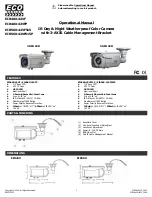
168
Additional Reference Information
Genie_TS_Series GigE Vision Camera
Lenses for the Genie TS with CS-Mount (2M or 4M)
Genie TS models TS-M1920 and TS-M2048, are designed for CS-mount lenses (or C-mount with an
adapter ring). The following graphic shows the relative image circle sizes of typical 2/3” and 1”
machine vision CS-Mount lenses.
When using a 2/3” lens with the TS-M1920, a slight drop in illumination at the sensor corners is
expected. The user should compensate by enabling Flat Field Correction after performing a FFC
calibration with the chosen lens. The graphic shows this model configured in the HD video format
of 1920x1080 pixels, verses its maximum format of 2048x1088 pixels.
For Genie TS model TS-M2048, a 1” lens is required to have proper illumination.
Additional Lens Parameters (application specific)
There are other lens parameters that are chosen to meet the needs of the vision application. These
parameters are independent of the Genie model (assuming that the Lens Mount and Lens Sensor
Size parameters are correct, as previously covered in this section). A vision system integrator or
lens specialist should be consulted when choosing lenses since there is a trade off between the best
lenses and cost. An abridged list of lens parameters follows – all of which need to be matched to
the application.
Focal Length
: Defines the focus point of light from infinity. This parameter is related to the
Genie mount (C or CS mount). See Camera Specifications — Back Focal Distance.
Field of View
: A lens is designed to image objects at some limited distance range, at some
positive or negative magnification. This defines the field of view.
F-Number (aperture)
: The lens aperture defines the amount of light that can pass.
Lenses may have fixed or variable apertures. Additionally the lens aperture affects Depth of
Field which defines the distance range which is in focus when the lens is focus at some
specific distance.
Image Resolution and Distortion
: A general definition of image quality. A lens with poor
resolution seems to never be in focus when used to image fine details.
Aberrations (defect, chromatic, spherical)
: Aberrations are specific types of lens faults
affecting resolution and distortion. Lens surface defects or glass faults distort all light or
specific colors. Aberrations are typically more visible when imaging fine details.
Spatial Distortions
: Describes non-linear lens distortions across the field of view. Such
distortion limits the accuracy of measurements made with that lens.
















































